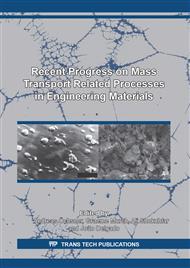[1]
J.M.P.Q. Delgado, A.G.B. Lima, M.J.N. Santos, Transport phenomena in liquid composite molding process, Springer International Publishing, Cham, (2019).
Google Scholar
[2]
W.C. Callister Jr., D.G. Rethwisch, Fundamentals of materials science and engineering: An integrated approach, third ed., Wiley, Hoboken, (2008).
Google Scholar
[3]
M.J.N. Santos, J.M.P.Q. Delgado, A.G.B. Lima, I.R. Oliveira, Liquid injection molding process in the manufacturing of fibrous composite materials: Theory, advanced modeling and engineering applications, in J.M.P.Q. Delgado, A.G.B. Lima (Eds.), Transport Phenomena in Multiphase Systems, Springer International Publishing, Cham, 2018, pp.251-272.
DOI: 10.1007/978-3-319-91062-8_8
Google Scholar
[4]
N. Wegh, S. Bachschuster, D. Gaudlitz, M. Klein, Three-dimensional simulation of the impregnation stage of the RTM process considering the local structure of the fiber layup, Comput. Methods Multiphase Flow, 8 (2015) 487-499.
DOI: 10.2495/mpf150411
Google Scholar
[5]
B.G. Coutinho, V.M.F. Bezerra, S.R. Farias Neto, A.G.B. Lima, A mathematical model for RTM process simulations in geometries with irregular shapes, Int. J. Metaphysics, 8 (2014) 285-296.
DOI: 10.1260/1750-9548.8.3.285
Google Scholar
[6]
M.J.N. Santos, A.G.B. Lima, Fluid flow in fiber porous medium: Application to the manufacture of polymer composite via RTM technique. In: 11th National Congress on Experimental Mechanics and 1st Iberic Conference on Theoretical and Experimental Mechanics and Materials, Porto, Portugal, 2018, pp.1-13 (In Portuguese).
Google Scholar
[7]
F.F. Luz, Comparative analysis of the fluid flow in experiments using RTM commercial applications, Master Dissertation in Mining, Metallurgic and Material Engineering, Federal University of Rio Grande do Sul, Porto Alegre, Brazil, 2011 (In Portuguese).
DOI: 10.17138/tgft(2)15-17
Google Scholar
[8]
T. Okabe, Y. Oya, G. Yamamoto, J. Sato, T. Matsumiya, R. Matsuzaki, S. Yashiro, S. Obayashi, Multi-objective optimization for resin transfer molding process. Compos.: Part A 92 (2017) 1–9.
DOI: 10.1016/j.compositesa.2016.09.023
Google Scholar
[9]
S.H. Han, E.J. Cho, H.C. Lee, K. Jeong, S.S. Kim, Study on high-speed RTM to reduce the impregnation timeof carbon/epoxy composites. Compos. Struct. 119 (2015) 50–58.
DOI: 10.1016/j.compstruct.2014.08.023
Google Scholar
[10]
A. Keller, C. Dransfeld, K. Masania, Flow and heat transfer during compression resin transfer moulding of highlyreactive epoxies. Compos. Part B 153 (2018) 167–175.
DOI: 10.1016/j.compositesb.2018.07.041
Google Scholar
[11]
P. Simacek, S.G. Advani, Resin flow modeling in compliant porous media: an efficient approach for liquid composite molding, Int. J. Mater. Form. 11 (2018) 503–515.
DOI: 10.1007/s12289-017-1360-9
Google Scholar


